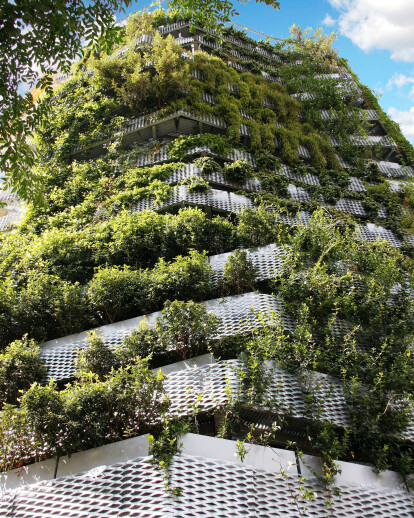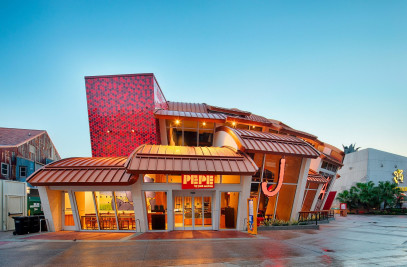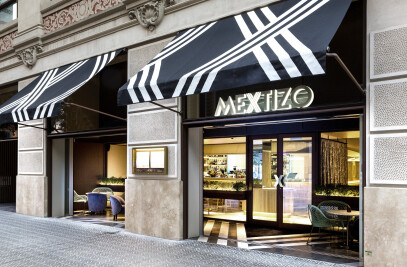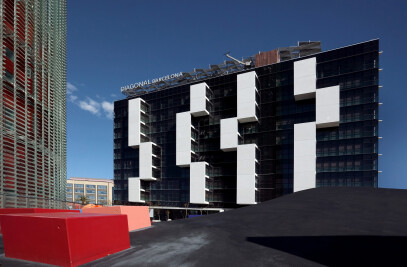The Green Side-Wall consists of a free-standing structure containing plants that form a protective mass of vegetation against a facade in Barcelona, thus creating a vertical garden. The demolition of an old building left a former party wall visible from the street, creating a negative visual impact on the cityscape because of its conspicuousness. A unique, integrative intervention was proposed that would use living material as one of its themes. It is promoted by the Barcelona City Council at the confluence of Carrrer Berlin with Carrer Marquès de Sentmenat, and it heralds the birth of novel type of construction in the field of “vegitecture”. It consists of a free-standing metal structure on an independent foundation, built in parallel with the blind facade of an existing building. From street level, the structure becomes gradually narrower as it rises, to a height of 21 metres. It consists of a ground-floor level and eight upper levels accessible by way of interior steps. From the first to the eighth level, metal platforms are provided on which the flower-trough modules are arrange perimetrally, on two distinct levels. These platforms can be reached, with restricted access, from the ground floor by way of interior steps. This convenience of access is precisely what differentiates this structure from other vertical greenery, maintenance and replanting of which always has to be done from the exterior using elevating platforms, making the process a difficult and expensive one requiring specialised labour.
There are many advantages and benefits of a green facade in a city centre, from both the environmental and aesthetic points of view. First of all, there is the obvious visual enhancement brought about by covering a formerly exposed blind wall in a city street. The green facade is a living surface, continually changing, that protects the wall of the building against the elements, providing cooling in summer and thermal insulation in winter. It generates oxygen and absorbs CO2. It protects against pollution, filtering the dust and other particulate contaminants, and against heavy rain and hail, as well as forming an acoustic screen that dampens noise. Finally, it propitiates the creation of a habitat occupied by many species of flora and fauna, thus contributing to biodiversity, which is so restricted in cities.
The entire structure is built in prefabricated galvanised steel assembled on site, to optimise anti-corrosive qualities. Similarly, the platforms on each level are galvanised expanded metal. The wall at ground-floor level resembles a dry-stone wall, built in rustic brown quartzite, which extends continuously into the paving of the little court opened up in front of the wall. Three plant troughs are located in this space as well as wooden benches integrated into the design, a fountain and an urban telescope enabling the flora and fauna to be observed in detail. Several cut-out silhouettes of birds in galvanised steel plate are positioned on the facade. For the maintenance of the vegetation that forms the facade, account has been taken of all current requirements for cleaning, safety and sustainability (including a pulley system to transport materials). Water consumption is minimised by means of an automatic programmed drop-by-drop irrigation system with controlled drainage and automatic dosing of fertiliser. Nesting boxes are also integrated. In general, the project has been inspired by the concept of “xeriscaping”, which advocates the rational use of irrigation water, the planting of local species, and, in general, ecoefficient design and maintenance criteria.
The free-standing structure is inspired by the form of a tree. The design of each level is different, giving the facade a dynamic appearance. Furthermore, its faceted shape benefits the distribution of the plants, enabling each variety to receive greater or lesser insolation. It forms a great three-dimensional screen, made up of the metallic structure and the flower troughs, which can accommodate different varieties of vegetation and flora. Thus, the overall appearance of the facade changes with the seasons, but it can also be modified over time or for some specific reason, anniversary, etc. A total surface area of 200 square metres that can display all sorts of shades and textures of green, or indeed different gamuts of floral colours. It is therefore a dynamic facade, always alive and always different.
CORE IDEAS
Advantages and benefits of the green side-wall
• A living surface • Changes with the seasons • Contributes to local environment • Ecological contribution, increasing biomass in the city • Visual improvement, enhancing the aesthetics of an exposed party wall • Protects the wall of the building against the elements • Cooling in summer and thermal insulation in winter, reduces energy consumption • Protecting the wall against direct sunlight, makes an efficient thermal insulator (shade) • Reduces heat fluctuation (50%) • Reduction of the exterior temperature by 5.5ºC = reduction of air-conditioning energy bill by 50–70%, cooling effect • Reduces heat loss in winter (walls opposite where sunlight falls) • Forms an air cushion between plants and wall • Screens against currents of cold air = 75% reduction in cooling, makes it possible to reduce energy demand by 25% (depending on the thickness of the plants (ivy 20 to 40 cm = better thermal insulator, Hedera helix) • Filters dust and other particulate contaminants. Protects against atmospheric pollution, capturing dust and contaminants; Hedera helix captures 6 g dust/m2 in one season • Protects against heavy rain and hail • Protection of constructional materials. Screens ultraviolet light (protection of wall cladding) • Urban acoustic screen. Reduces and dampens exterior noise • Contributes to the biodiversity of the urban space: - Presence of large numbers of invertebrates = food for birds = nesting sites - Source of food for insects, hibernation sites
Elements of design
• Easy maintenance: regular programme, substitution of plants, cleaning of structure and installations, removal of flammable elements (dead leaves) = electric pulley system • Fire-safety system • Safe from vandalism, different wall treatment on ground floor, anti-graffiti • Protection of maintenance circuit, life-line, grilles… • Safe maintenance: Parks and Gardens, folding ladder, access key • Lightning-protection system • Minimum overhang height, 2.50 m (regulation) • Autonomy of structure, inspired by a tree • Automatic watering with drop by drop metred system. Minimisation of water consumption • Dosing of fertiliser/nutrients • Lightened soil, anti-evaporation in summer • Controlled drainage • Prefabricated galvanised steel structure, with anti-corrosion treatment; cables with plastic casing, light-coloured, anti-reflective materials, small diameter (heating) • Prior waterproofing and insulation of the side wall of the existing building • Integration of nesting-boxes • Modular plastic flower troughs, light, easily substituted, standard dimensions 1000 x 320 x 550 (h) mm • Wall built with brown Bierzo quartzite, laid in the manner of a dry-stone wall, which continues into the paving in front of the facade to form a little courtyard • Street furniture integrated into the design • Integration of information and identification plaques • Xeriscaped garden with very low water consumption, efficient water use, using indigenous and endemic species…
Types of plants
• Ecological aspects: source of nectar for insects (flowers), fruits for birds and insects • Chromatic diversity • Shade for roots • Plants used for initial planting: Base planting: Muehlenbeckia complexa, Ficus plumilla, Hedera helix, Jasmininum polyenthum, Viurnum tinus, Partenococisus quinquefolia. Secondary planting: Aptenia, Plumbago, Eleagnus, Sedum.

































